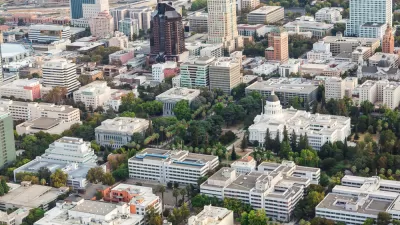A companion bill to the controversial SB 827, also introduced Sen. Scott Wiener (D-S.F)., could have a similar impact on housing production but hasn't gathered nearly as much attention. SB 828 makes critical changes to the state's housing supply law.
"The legislation, Senate Bill 828, from state Sen. Scott Wiener (D-San Francisco), would require cities and counties to rezone land in their communities to permit many more homes than are currently in their plans," reports Liam Dillon, who covers housing legislation for the Los Angeles Times, on April 12.
Under the bill, local governments could have to double the amount of land made available for condominium and apartment complexes, and zone even more parcels for residential development in an effort to address a shortage of homes in the state that Wiener has estimated stands at 4 million.
An October 2016 McKinsey Global Institute report estimated the state shortage at 3.5 million homes.
Wiener wants to implement the new zoning through changes to the state's housing supply law, which for the last 50 years has aimed to spur the construction of enough housing at all income levels to keep pace with California's growth.
That law is formally known as the Regional Housing Needs Allocation or RHNA (pronounced "Rina"). On a regional level, it goes by Regional Housing Needs Assessment.
The law compels cities and counties to zone enough land in their communities to accommodate projected population increases, so theoretically developers have enough places to build.
The law doesn't work, reported Dillam in an eye-opening piece last June. "The law requires cities and counties to produce prodigious reports to plan for housing — but it doesn’t hold them accountable for any resulting home building," he wrote then.
Even if city leaders want to build the new homes, they face many challenges, "including developers' construction and financing costs, competing state environmental regulations and often lengthy approval processes for projects," adds Dillon.
The state Department of Housing and Community Development [HCD] has estimated that developers need to build 180,000 new homes a year simply to keep pace with California's population growth. [See Construction Industry Research Board for actual housing production data (pdf) from 1954 to 2016.]
In 2016, statewide housing production topped 100,000 units, the first time since 2007.
Just two of 539 cities and counties met housing production goals at all four [lextremely low to moderate] income levels during the eight-year period that ended in 2014, according to a Times review of housing department data.
Only 13 cities and counties met their required housing production goals for HCD as of Jan. 31 for the 2016 Annual Progress Report, leaving 97 percent of cities and counties subject to what is now known as the SB 35 streamlining or by-right approval process in reference to Wiener's landmark housing legislation last year. Mixed-use developments with 50 percent affordable housing proposed in Berkeley and Cupertino in the Bay Area are going through that 180-day approval process now.
Among the ways SB 828 would alter the existing RHNA requirements to ensure more housing is ultimately built:
- Doubling the amount of land intended to house very low- and low-income residents by setting aside more properties for apartments and condominiums.
- Zoning land to account for homes not built under production goals from the prior eight years. [The state resets the numbers and reallocates the targets to local governments every eight years.]
- Zoning even more land for residential properties if a state audit shows there’s a shortage in that community.
In addition, Wiener's bill would give the state more of a say in the numbers each city, currently determined by the regional planning agencies like the Southern California Association of Governments and Association of Bay Area Governments, adds Dillon.
So would Assembly Bill 1771 from Assemblyman Richard Bloom (D-Santa Monica), which also would allow outside groups to weigh in on the number of homes that should be built in each community.
The bill is co-sponsored by the Western Center on Law & Poverty (see their bill description [pdf]) and the California Rural Legal Assistance Foundation and opposed by the California Association of Councils of Government and California Building Industry Association, according to the April 9 legislative analysis.
Overreach?
Zoning more land for housing doesn't guarantee housing construction, particularly for extremely low-income units which often require subsidies. However, SB 35 could have an impact, as it applies only to land zoned residential, which there should be more of should both SB 239 and AB 1771 become law.
The director of HCD, Ben Metcalf, who has not taken a position on the bill, was cautious.
"We need to push and we need to make sure we're bringing cities along on the journey to the greatest extent possible at the state" he said. "But there is also a risk of overreach."
In contrast to Wiener's transit-rich housing bonus bill, SB 827, which has attracted nationwide attention, "SB 828 has garnered less interest because its changes are harder to understand and predict," said Greg Morrow, director of the Fred Sands Institute of Real Estate at Pepperdine University.
Hat tip to Steve Birdlebough.
FULL STORY: A little-known bill could reshape housing development across California

Planetizen Federal Action Tracker
A weekly monitor of how Trump’s orders and actions are impacting planners and planning in America.

Restaurant Patios Were a Pandemic Win — Why Were They so Hard to Keep?
Social distancing requirements and changes in travel patterns prompted cities to pilot new uses for street and sidewalk space. Then it got complicated.

Map: Where Senate Republicans Want to Sell Your Public Lands
For public land advocates, the Senate Republicans’ proposal to sell millions of acres of public land in the West is “the biggest fight of their careers.”

Maui's Vacation Rental Debate Turns Ugly
Verbal attacks, misinformation campaigns and fistfights plague a high-stakes debate to convert thousands of vacation rentals into long-term housing.

San Francisco Suspends Traffic Calming Amidst Record Deaths
Citing “a challenging fiscal landscape,” the city will cease the program on the heels of 42 traffic deaths, including 24 pedestrians.

California Homeless Arrests, Citations Spike After Ruling
An investigation reveals that anti-homeless actions increased up to 500% after Grants Pass v. Johnson — even in cities claiming no policy change.
Urban Design for Planners 1: Software Tools
This six-course series explores essential urban design concepts using open source software and equips planners with the tools they need to participate fully in the urban design process.
Planning for Universal Design
Learn the tools for implementing Universal Design in planning regulations.
Heyer Gruel & Associates PA
JM Goldson LLC
Custer County Colorado
City of Camden Redevelopment Agency
City of Astoria
Transportation Research & Education Center (TREC) at Portland State University
Camden Redevelopment Agency
City of Claremont
Municipality of Princeton (NJ)





























